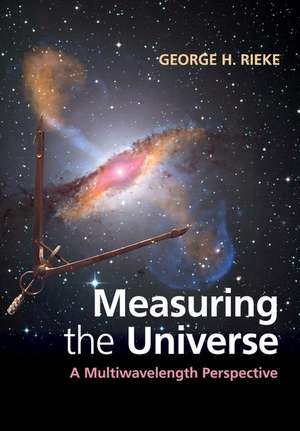Measuring the Universe: A Multiwavelength Perspective
Autor George H. Riekeen Limba Engleză Paperback – 24 mai 2017
Preț: 355.39 lei
Nou
Puncte Express: 533
Preț estimativ în valută:
68.00€ • 74.17$ • 57.34£
68.00€ • 74.17$ • 57.34£
Carte tipărită la comandă
Livrare economică 24 aprilie-08 mai
Preluare comenzi: 021 569.72.76
Specificații
ISBN-13: 9781108405232
ISBN-10: 1108405231
Pagini: 355
Ilustrații: 175 b/w illus. 50 exercises
Dimensiuni: 172 x 245 x 18 mm
Greutate: 0.57 kg
Editura: Cambridge University Press
Colecția Cambridge University Press
Locul publicării:Cambridge, United Kingdom
ISBN-10: 1108405231
Pagini: 355
Ilustrații: 175 b/w illus. 50 exercises
Dimensiuni: 172 x 245 x 18 mm
Greutate: 0.57 kg
Editura: Cambridge University Press
Colecția Cambridge University Press
Locul publicării:Cambridge, United Kingdom
Cuprins
1. Introduction; 2. Gathering light - the telescope; 3. Sensing the light: detectors for the optical and infrared; 4. Imaging and astrometry; 5. Photometry and polarimetry; 6. Spectroscopy; 7. Adaptive optics (AO) and high contrast imaging; 8. Submillimeter and radio astronomy; 9. Interferometry and aperture synthesis; 10. X-ray and gamma-ray; Index.
Recenzii
'This text fills a long-standing need for a broad treatment of modern observational astronomy techniques suitable for graduate and upper-division undergraduate students of astronomy, physics, and engineering. It provides useful descriptions of practical issues that are encountered when applying the techniques and technologies.' Jason Glenn, University of Colorado, Boulder
'Rieke is an ambassador of astronomical hardware, making the world of telescopes, instruments and detectors intelligible and palatable to observers, and those who analyze and model data. This textbook, written for advanced undergraduate and graduate students, provides an excellent starting point and overview for those who venture into building hardware. For those who just use astronomical facilities and data, the book provides precisely all they 'need to know'.' Hans-Walter Rix, Director, Max Planck Institute for Astronomy, Heidelberg
'This textbook fills a real void. It is an excellent overview of the broad range of tools, technologies, and principles that modern observational astronomers use to address the major frontier areas of research. In our era of multi-waveband 'panchromatic' observations, this book will be a valuable resource for educating graduate students and an excellent reference for senior observational astronomers who are venturing into new territory.' Timothy Heckman, Dr A. Hermann Pfund Professor of Physics and Astronomy, Johns Hopkins University
'This excellent textbook has the range and depth to provide a great introduction to the techniques of modern astronomy for senior undergraduates or physics graduates starting an observational PhD with data from one of the major ground or space observatories. From traditional telescopes to gravitational wave detection it brings together in one reference the barrage of approaches we now use to unravel the secrets of the Universe.' Gillian Wright, STFC UK Astronomy Technology Centre
'… this is a directory on extant technology and as such is a useful and comprehensive directory in itself. But it is much more than that alone, covering telescopes, detectors, photometry, spectroscopy, adaptive optics and high-contrast imaging, millimetre-wave and radio reviewers, radio and optical infrared interferometry, and X-ray and gamma-ray astronomy. … Where this book derives its greatest value is in the focus on instruments and detectors …' Spaceflight
'Measuring the Universe provides a backbone of understanding to build on. Among its major strengths are its spare and uncluttered style, its good use of equations and figures, and its problem sets.' Physics Today
'Rieke is an ambassador of astronomical hardware, making the world of telescopes, instruments and detectors intelligible and palatable to observers, and those who analyze and model data. This textbook, written for advanced undergraduate and graduate students, provides an excellent starting point and overview for those who venture into building hardware. For those who just use astronomical facilities and data, the book provides precisely all they 'need to know'.' Hans-Walter Rix, Director, Max Planck Institute for Astronomy, Heidelberg
'This textbook fills a real void. It is an excellent overview of the broad range of tools, technologies, and principles that modern observational astronomers use to address the major frontier areas of research. In our era of multi-waveband 'panchromatic' observations, this book will be a valuable resource for educating graduate students and an excellent reference for senior observational astronomers who are venturing into new territory.' Timothy Heckman, Dr A. Hermann Pfund Professor of Physics and Astronomy, Johns Hopkins University
'This excellent textbook has the range and depth to provide a great introduction to the techniques of modern astronomy for senior undergraduates or physics graduates starting an observational PhD with data from one of the major ground or space observatories. From traditional telescopes to gravitational wave detection it brings together in one reference the barrage of approaches we now use to unravel the secrets of the Universe.' Gillian Wright, STFC UK Astronomy Technology Centre
'… this is a directory on extant technology and as such is a useful and comprehensive directory in itself. But it is much more than that alone, covering telescopes, detectors, photometry, spectroscopy, adaptive optics and high-contrast imaging, millimetre-wave and radio reviewers, radio and optical infrared interferometry, and X-ray and gamma-ray astronomy. … Where this book derives its greatest value is in the focus on instruments and detectors …' Spaceflight
'Measuring the Universe provides a backbone of understanding to build on. Among its major strengths are its spare and uncluttered style, its good use of equations and figures, and its problem sets.' Physics Today
Notă biografică
Descriere
A one-stop guide to astronomical instrumentation and data acquisition, with a focus on the underlying principles behind each instrument's operation.
